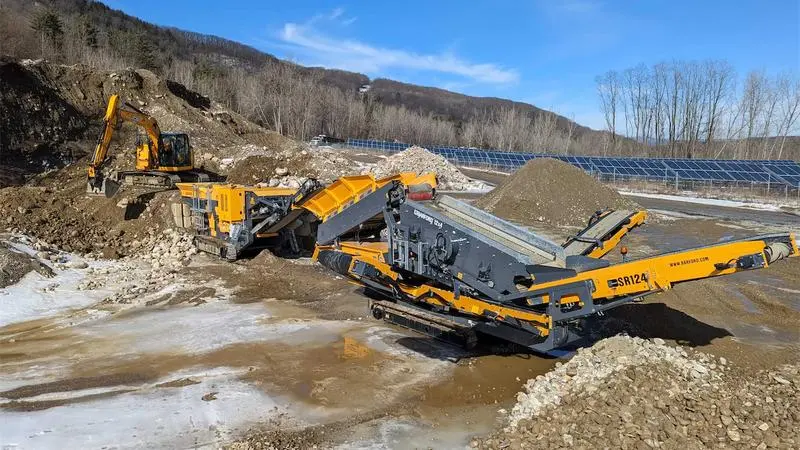Mobile, efficient, and versatile equipment is becoming more and more important in today’s fast-paced construction and mining environment. A portable stone crusher is a piece of equipment that can meet all these needs. A portable rock crushing machine can crush concrete and stone right on the site. This will reduce transport costs and increase productivity, whether you are working at a remote mining operation or on a construction project. It is important to set up the crusher correctly in order to get the most out of it. This guide covers everything you need to know to get started with portable rock crushers, from the site preparation to the essential components and safety guidelines.
1. Site Evaluation And Preparation
Prior to bringing a portable rock-crushing machine on site, you should carefully evaluate and prepare the area. You should choose a flat and stable surface that can hold the weight of your crusher as well as the material to be processed. When choosing a site, take into consideration the following:
- Accessibility: Make sure that trucks and loads can move freely.
- Safety zones: Maintain an adequate clearance between personnel and equipment.
- Drainage: Do not allow water to collect in low-lying areas.
Clean up the area by removing all loose materials, overhead obstructions, and unnecessary equipment.
2. Power Supply And Fuel
Depending upon the model, a portable rock crusher may require electric power, diesel fuel, or a combination of both. Confirm power requirements before you start:
- For electric crushers, you will need a reliable on-site generator or power supply.
- Diesel Crushers are required to be stored, handled, and ventilated properly.
- Model hybrids are more flexible, but they require a better understanding of the two systems.
A ready supply of fuel or energy can prevent expensive delays and ensure a smooth run.
3. Equipment Checklist
In order to run a portable crusher efficiently, there are several pieces of essential equipment and tools you’ll require:
- Feeder: To regulate the flow of the raw material into the crusher.
- Loader: To feed material to the crusher.
- Conveyor belts: To move crushed material to a desired location or stockpile.
- Screening device: Sorts crushed material according to size.
- Dust-suppression system: essential for compliance, safety, and cleanliness on dusty sites.
4. Assembly And Alignment
Most portable crushing machines are already pre-assembled to allow for rapid deployment. Although, the proper installation still requires care.
- Stabilize the unit using support legs or jacks.
- Alignment is required for all components, including feeders, conveyors, and other parts.
- Inspect connections, such as bolts, hydraulic lines, and cables.
You can avoid losing your warranty by following the instructions in the manual.
5. Calibration
You should calibrate your portable rock crusher to meet your output goal once assembled. This includes:
- Setting the feed and crushing gap for the desired size.
- Adjusting conveyor speed for optimal material flow
- Testing the hardness of material to prevent overloading a crusher
Short-term testing with a limited amount of material is recommended. Monitor vibration levels. Also, monitor motor temperature. This test run helps you identify and resolve any issues before a full-scale operation.
6. Operator Training And Safety Protocols
Safety must be paramount in both the installation and operation. Portable rock crushers are noisy, vibrate, and produce dust. Operators should wear:
- Protective Equipment: Safety glasses, hard hats, gloves, dust masks, and ear protection.
- Training: Operators are required to understand the model and make specific adjustments to the crusher.
- Emergencies: Emergency shutoff switches and fire extinguishers are to be located in a visible location.
Assure that all workers on-site are aware of the hazards associated with crushing machines and follow safe operating procedures.
7. Environmental And Legal Compliance
Check local regulations about noise, dust control, and the environmental impact. Some important compliance steps include:
- Dust Reduction Using Water Sprays or Misting Systems
- Noise control using barriers or equipment
- Permits are required to perform temporary crushing operations.
Operating a mobile rock crusher without permits or proper environmental controls can lead hefty fines as well as project shutdowns.
Conclusion
Setting up a portable rock crusher might appear straightforward. However, the success of any operation depends on proper planning and preparation, as well as alignment of the equipment and the operator’s training. A well-prepared portable crusher can be used to improve project efficiency. It can also reduce costs for material transport and provide real-time on-site processing.
It doesn’t matter if you’re in road construction or demolition. Investing time and energy in the initial set-up will pay off over the long term. When you’re equipped with the proper knowledge, tools, and a team to work with, your portable rock-crushing unit will become an asset at your job site.







